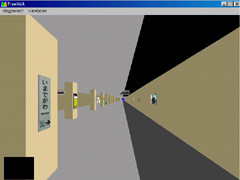Toshitomo Suzuki and Shigeyuki Okazaki,
Comparison of Visual Search and Pedestrian Movements in Way-finding at Virtual and Real Subway Stations,Journal of Architecture, Planning and Environmental Engineering (Transaction of AIJ), No.555, pp.199-205, 2002.5To clarify key points of human behavior through virtual spaces by using a keyboard and flat screen, the same experiment was conducted in both a real and virtual subway station. Subjects wearing an eye camera got off the train and tried to find a specified exit. Four significant characteristics of virtual space were found: 1) short duration fixations hardly occurred, 2) subjects found it difficult to determine the distances between themselves and other objects, 3) passive and delayed fixations, not found in real space, were found, and 4) some activities easily done in a real space were difficult in virtual.
Yuuki Nakamura, Toshitomo Suzuki, Shigeyuki Okazaki and Shigeyoshi Sugai, The Methods of the Experiments of Way-finding in Real and Virtual Subway Stations- Visual Search and Pedestrian Movements in Way-finding in Real and Virtual Subway Station, Part 1 -Summaries of Technical Papers of Annual Meeting Architectural Institute of Japan, E-1, pp.751-752, 2001.9 This paper explains the methods of Way-Finding experiment in real and virtual subway stations.In the real subway station,subjects wearing eye-camera try to find exit 4 following signs on the platform.However,in the virtual station,computers are used in the process to find exit 4.In this experiment,the texts on signs in virtual station are made bigger than those in real station,because of legibility.In the following study,we compare the data in the two experiments and find the characteristics of eye-fixation in virtual station. PDF(in Japanese, 280KB)
Shigeyoshi Sugai, Toshitomo Suzuki, Shigeyuki Okazaki and Yuuki Nakamura, A Study on Characteristics of Eye-fixation in a Virtual Subway Station- Visual Search and Pedestrian Movements in Way-finding in Real and Virtual Subway Station, Part 2 -Summaries of Technical Papers of Annual Meeting Architectural Institute of Japan, E-1, pp.753-754, 2001.9In this paper, we clarify the differences in eye-fixation movement between a real subway station and a virtual subway station. The eye-fixation movements have four main characteristics in the experiment of the virtual subway station. 1.Increased time of eye-fixations on the floor. 2.Increased time of slanting eye-fixations 3.Charcteristics of eye-fixation movements on sign-boards 4.Charecteristics of eye-fixations. We estimated four reasons for such characteristics. 1.Subjects do not walk in reality. 2.The difficulty of controlling one's movements in a virtual subway station using the Free Walk-VRML. 3.The unrealistic environment in the virtual subway station. PDF(in Japanese, 298KB)
Shingo Nakamura, Akihiro Ito, Toshitomo Suzuki, Takashi Tokunaga and Shigeyuki Okazaki, Fixation and Pedestrian Movements at a Virtual Subway Station- Path-finding at a Subway Station, Part 2 -,Summaries of Technical Papers of Annual Meeting Architectural Institute of Japan, E-1, pp.813-814, 1999.9
Toshitomo Suzuki, Shingo Nakamura, Takashi Tokunaga, Akihiro Ito and Shigeyuki Okazaki, Comparison of Fixation between at a Virtual Subway Station and at a Real Subway Station- Path-finding at a Subway Station, Part 3 -,Summaries of Technical Papers of Annual Meeting Architectural Institute of Japan, E-1, pp.815-816, 1999.9
|

|
